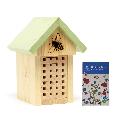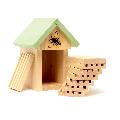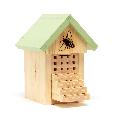Unhappy with your item? We offer no-quibble free returns
Sourced through ethical and sustainable accreditations
£3.95 standard UK shipping, or free shipping over £40
Every purchase you make supports wildlife




Solitary bee house with wildflower seeds
- Special offer includes a pack of wildflower seeds
- Specially designed for leaf cutter and red mason bees
- Made in the UK from FSC® certified pine
- Save £1 with this value pack
- Makes a great gift for nature lovers
FREE UK delivery with orders over £40
Product description
-
SPECIAL OFFER - Save £1 with this brilliant value pack.We have already applied the discount to this pack. Simply add it to your basket.
Rather than living in colonies, the vast majority of our bees are solitary, with each female building her own nest. These non-aggressive, highly efficient pollinators are important to our ecosystem and economy, including the pollination of many of our fruit and vegetable crops. Having a variety of pollinator-friendly plants in your garden over the summer is a great way to help, while providing a safe, cosy nesting site will also make a big difference.
RSPB Solitary bee home
Specially designed for two common bee home dwellers; the leafcutter and red mason bees. This high-quality bee home comes with removable nesting trays, metal fastenings for secure sitting, and an overhanging roof to protect bees from the rain. The apex roof is painted (using non-toxic paint) a light sage green and matches the style of some of our most popular bird nest boxes.
- Made in the UK
- Made from pine.
- Bespoke 8mm and 10mm nest holes for red mason and leafcutter bees.
- Optimal 15cm hole depth ensuring plenty of eggs are laid and protected.
- Removable trays for inspection and cleaning.
We would recommend cleaning the home every 1 to 2 years. You can either clean your home once nests have vacated in Spring or at the end of the breeding season (late September to October). The trays can be cleaned with a brush and mild, non-toxic disinfectant such as Ark-Klens.
If you are cleaning in late September-October, please carefully remove any bee cocoons present and place these in a ‘release box’ where they will stay until the following Spring.
A small container, ideally made of natural materials such as cardboard or wood, can be used as a ‘release box’ (e.g. a capped toilet roll). Avoid metal containers. Plastic boxes can be used, but the lid should be left loose and the bottom lined with tissue to prevent condensation. The box will need a small hole (minimum 10mm diameter) to allow bees to emerge in Spring.
The release box should be kept somewhere cool and dry (for example a garden shed or garage) during the winter months and then placed outside in Spring for the bees to emerge when ready.
RSPB Best for bees wildflower seed pack
We all know how important bees are to our eco-system. Even giving over a small area of your garden to wildflower seeds can make a massive difference to the prospects for our buzzy friends.
Adrian Thomas, our own resident garden expert, helped compose this mix of annual flowers. “These are flowers I grow every year because they are some of the very best for attracting bees, plus they are easy to grow,” he says.
“The flowers are not only great for bees but will add loads of colour to your garden. Bees prefer blue flowers, so the Phacelia, Borage, Echium and Cornflower are a vibrant mix of blues, spiced up with rich-red Common Poppies.”
Sow the seeds evenly over a sunny area of your garden that you have dug over, raked and weeded. This pack will cover an area of about 5 square metres so if your patch is smaller, decrease the sowing rate accordingly.
After sowing, lightly tread or roll the seed area to ensure the seed is in good contact with the soil, and keep it watered until the plants are established. Allow the flowers to bloom and release their seeds back into the soil. Cut them down to the ground as the plants die off, and remove the cuttings onto the compost heap or into your green bin.
- Plant outdoors between March and May or August and October.
- Plants will flower between May and September.
- All seeds grown in the UK.
- Annual seeds.
- This 5g pack will cover approx. 5 square metres of ground.
- The plants will grow up to 1.2 metres tall in very rich soil, but in most gardens will grow to about knee height.
- Fully recyclable paper packaging, printed with vegetable based inks.
- Seeds grown without any pesticides.
- If you want to grow this mix again in the same patch next year, just cultivate the ground in the same way, removing any weeds, before sowing a fresh packet
Typical content: 30% Cornflower, 30% Phacelia tanacetifolia, 20% Borage, 10% Echium 'Blue Bedder', 10% Poppy *
*Contents may vary.
Please note: Unfortunately, we cannot deliver this seed pack to Northern Ireland. We apologise for any inconvenience.
- Free UK delivery for orders of £40 or more (or £3.95)*
- Please allow 3-5 working days for in stock items to be delivered
See our delivery and returns page for full details.


